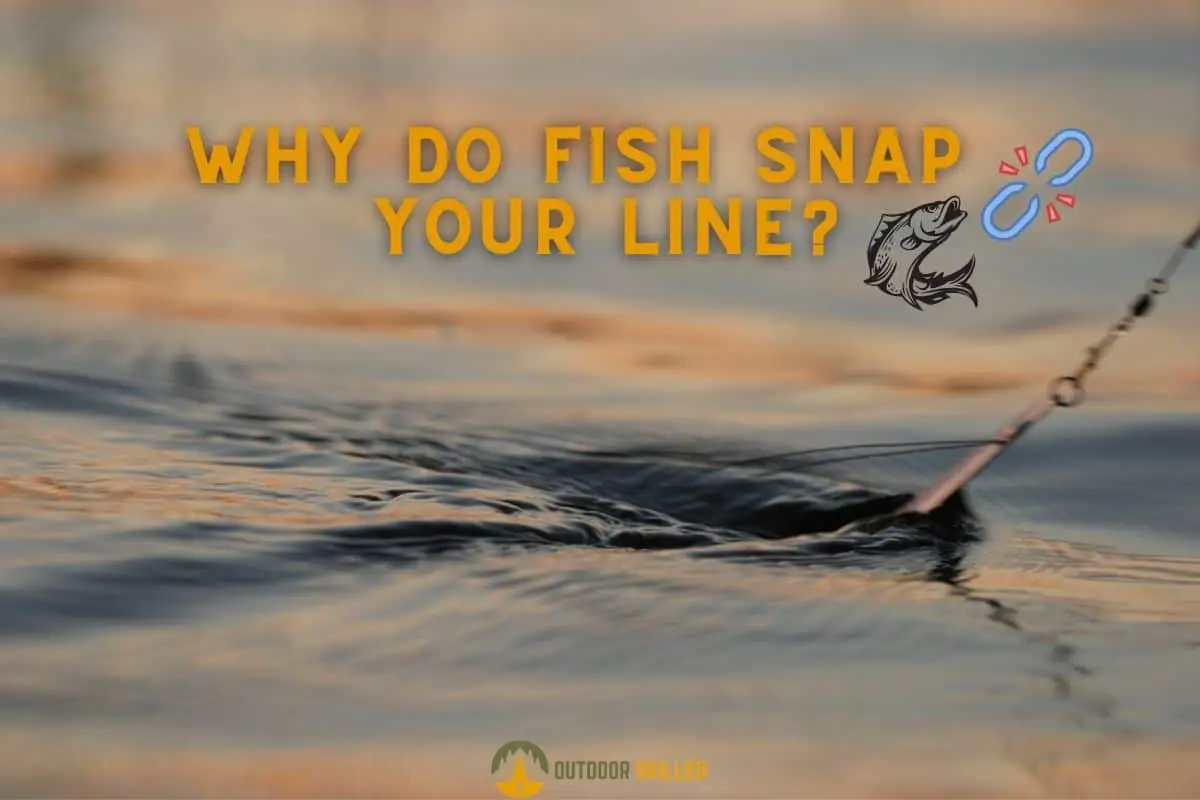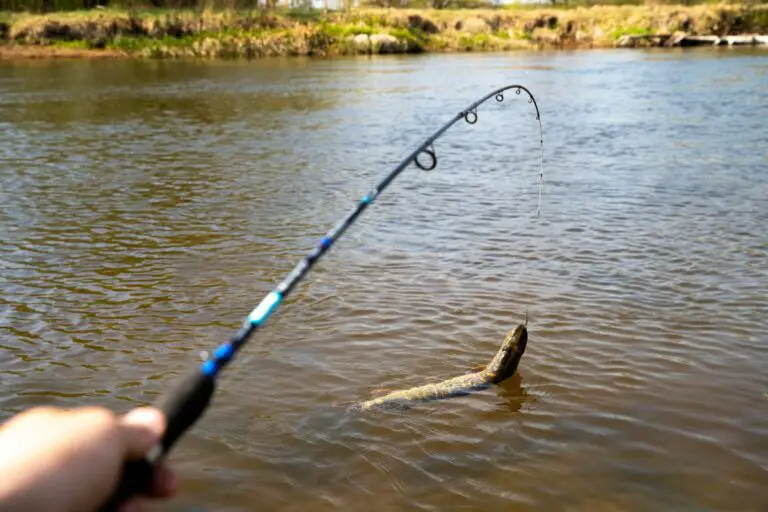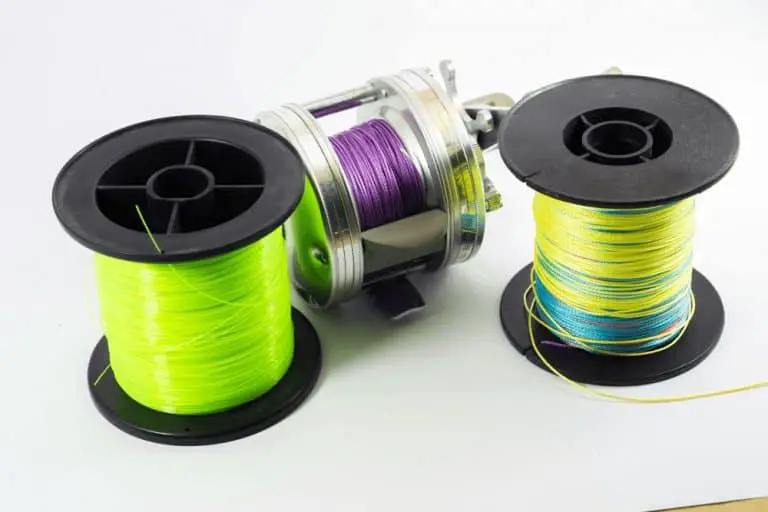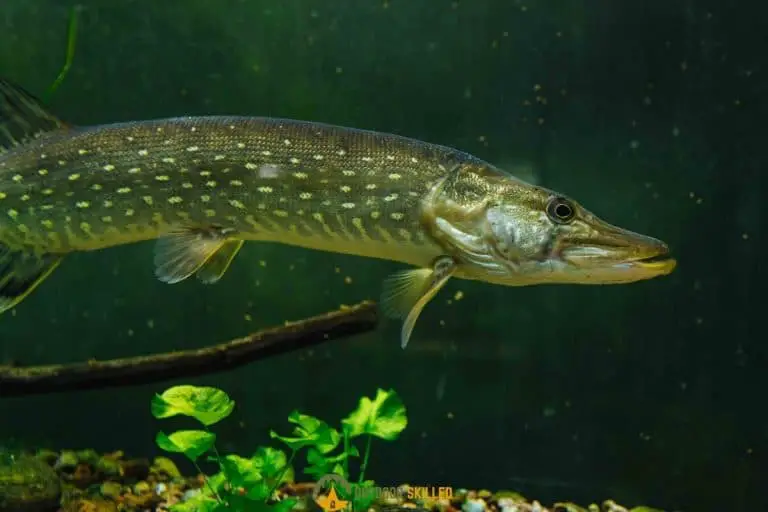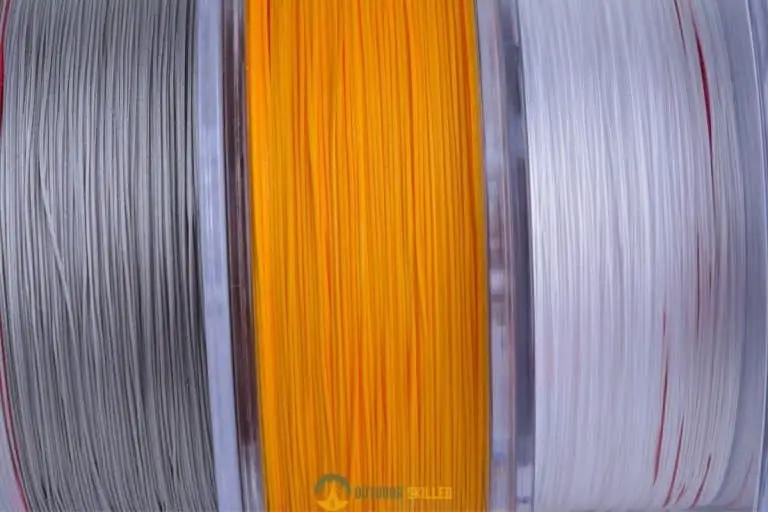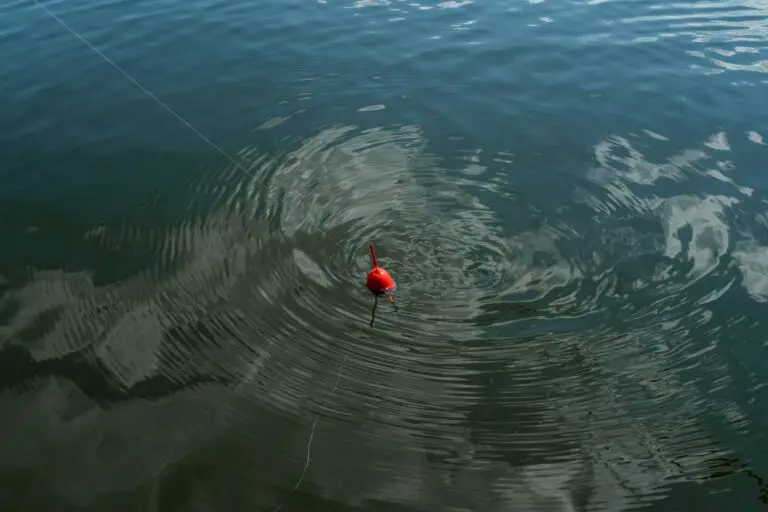Why Do Fish Keep Snapping My Line? 10 Reasons & Solutions That Work
It can be really frustrating to have your line snap when you’re so close to catching a fish. But don’t be discouraged; the solution is easy. Familiarizing yourself with different kinds of fishing lines, and learning some pointers about their care and how to choose the right kind will make all the difference.
So, Why do fish keep snapping your line? The reason why fish keep snapping your line could be that the drag set is too tight, your line has some damage or it’s getting too old, your line test is too light, or it could possibly be that your technique when playing the fish is not right.
There are, of course, many more reasons why this may be happening more than usual to you, so let’s break them down in a bit more detail and see how you can identify these reasons and solve each of them.
Table of Contents
10 Reasons Why Fishing Line Keeps Snapping Your Lines (and The Solutions)

Your fishing line is the link between you and your catch. It’s one of the most important tools in any angler’s kit. A slight issue with your line could greatly impact your fishing performance. It’s important to identify first the reasons why your fishing line keeps on breaking, then you’ll know how to prevent it from happening.
So, here’s a list of reasons that are causing your line to keep breaking…
- Your drag is set too tight
- This is one of the most common mistakes among beginners, which may result in the breaking of the fishing line.
- Drag is something that has to be set with balance. It should always have enough pressure so that you can keep reeling your line in, but also loose enough for when a fish does try to surge.
- The best solution is to set your drag to 25% to 30% of your line strength. So if you’re doing a 10 test line, it should be about three pounds.
- Your fishing line has a bird’s nest
- This is what most experts call “professional overrun” on your reel.
- A fishing line often forms a shape similar to a bird nest, especially when a fish bites the bait.
- This in the long run will lead to the breaking of the fishing line
- Sometimes fishing reels have the necessary mechanisms to control these backlashes, but they may not operate correctly most of the time.
- The best solution is practicing having your thumb be more sensitive in shifting conditions like following the wind when casting.
- This method can also help you with avoiding tangles.
- You’re rushing your knots
- Most beginners are likely to rush their knots when tying a new lure so they forget to wet the knot and to clinch it down quickly.
- Not wetting the knot and clinching it creates friction and burning, which is what causes the fishing line to break.
- The best solution is to be careful when tying your knots and avoid overlaps. Pull the knots tight slowly, so that you can avoid friction and wet your line before cinching it.
- It’s also good to use the best knot that the fishing line manufacturer recommends in order to avoid any damage to the line.
- You’re not changing your fishing line often.
- Fishing lines aren’t meant to last you forever. Ideally, a fishing line should be changed at least once a year.
- You have to regularly check on your lines and take into consideration the quality of your fishing line because they can go bad over time.
- Environmental conditions like weather, heat, and light affect the performance of a fishing line.
- The best solution is to change your fishing line if you notice any signs of damage.
- You are storing your fishing line under extreme lights or in extreme heat.
- It’s important to understand that proper storage has a powerful effect on the quality of a fishing line.
- Storing lines in direct sunlight will cause more damage to the structure of the fishing line.
- Also storing your line while wet will cause it to be damaged faster than a dry line.
- The best solution is to store all your fishing lines in a cool dark space. This method will ensure that your fishing line can last longer.
- You strap your lures too tight.
- This is one of the most common mistakes with beginners, which may result in the breaking of the fishing line.
- The best solution to it is to avoid fastening the fishing line down too tightly. You don’t have to tighten everything so much. You just need to make sure that everything is in place as well as provide enough pressure on your knots.
- You have an overlapping fishing line
- The best solution, in this case, is trying to keep the tension even on the fishing line when you’re spooling.
- Keep the pressure focused on the center of your fishing rod so that you can get a better spool on your fishing reel.
- You’re Casting on Dirty Water.
- Dirty or salty water can have a negative on your fishing line.
- The dirt will stick to the fishing line, which can lead to severe damage and fast deterioration.
- Areas that have lots of sharp grass and weeds, structures, and branches can also ruin your fishing line.
- The best solution is to keep in mind where you’re fishing and what kind of line you’re using.
- You are Casting on Rocky Areas.
- If you go on stream fishing rocky areas, there’s a huge possibility that your fishing line will break.
- Hard water can cause a lot of damage to your fishing line, and ruin its quality.
- Your fishing line has a nick on it.
- A nick on your fishing will reduce its strength by almost 50%. There can be some possible reason why you have a nicked fishing line like a rough guide, rubbing the side of your boat, or a log or rock.
- Even the scales from your target fish can cause your line to be nicked after a hard struggle.
- The best solution here is to always check for nicks in your fishing line by running two pinched fingers over the length of the line and checking for any roughness as an indication of a nicked part.
What Are the Types of Fishing Lines?
Each type of fishing line has different properties as well as different sets of advantages and disadvantages. Some types of lines might be more or less prone to breaking depending on various factors such as frequency of use, line quality and structure, storage, and type of water.
First, you need to learn the key factors that determine the quality of a line:
- Line Breaking Strain: This is how much weight is needed to break the line. The bigger the fish you are targeting the higher the breaking strain on the line needs to be.
- Line Diameter: This is the thickness of the line. The higher the breaking strain of a line the thicker the line is. A thicker line is more likely to scare fish away from your bait.
- Line Stretch: There are benefits and disadvantages to both stretchy and stretch-free lines; it all comes down to the distance you want to fish from the bank, how accurately you need to cast and how sensitive you expect your line to be
- Line Memory: This refers to the fishing line’s ability to retain its shape and it can be affected by how stretchy the line is. Generally, when it comes to fishing, less fishing line memory is often better.
- Abrasion Resistance: The more resistant a line is to abrasion the longer it will last.
Now, let’s have a look at the 3 main types of fishing line:
Monofilament line
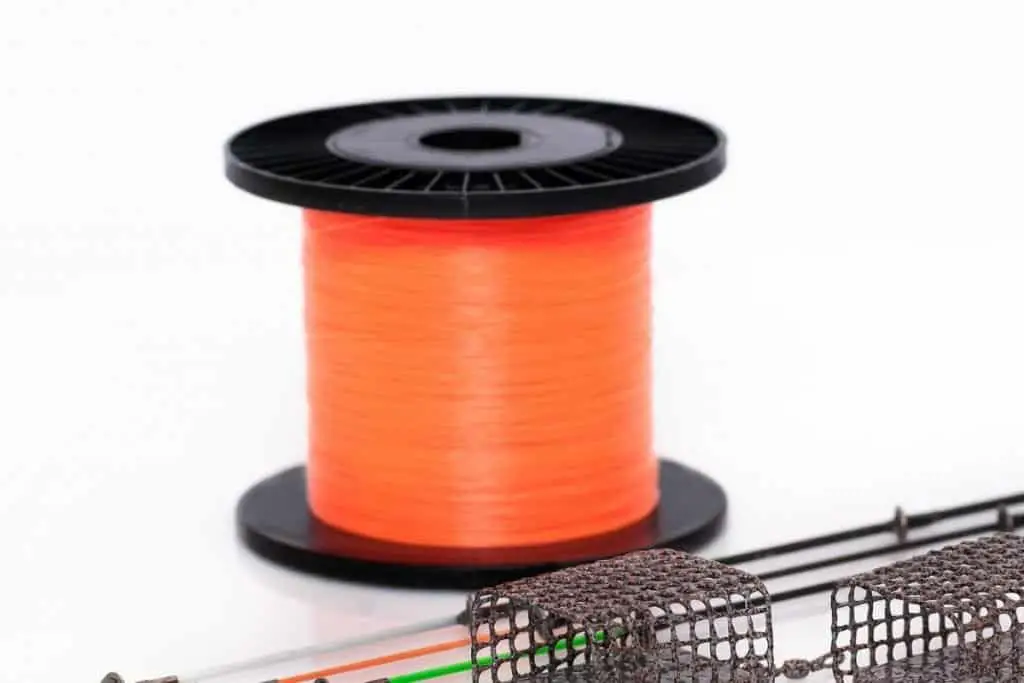
- Monofilament fishing line is possibly the most popular choice among beginners. It’s multi-purpose as well as affordable.
- It’s made using one continuous strand of line. The material used is a synthetic fiber made out of nylon, which makes it cheap to manufacture.
- It’s translucent and very easy to dye, which means that it comes in a variety of colors, so you can choose a color that best suits your fishing environments or that would be ideal for situations when you need to watch your line closely.
- It’s the most resistant to abrasion damage and with proper storage, it can last you a long time.
- It is also very stretchy; this has the benefit of being able to absorb the shock of an aggressive bite or a hooked fish rapidly kicking or changing direction. However, a stretchy line could also have some drawbacks. It can make it difficult to judge the casting distance and cause overcasting.
- Another drawback for monofilament lines is that it’s very susceptible to UV light damage, which degrades its quality faster.
You can check the best monofilament lines here. These are the ones I’ve tested myself for years and have proven their worth, so definitely check them out.
Fluorocarbon line

- Fluorocarbon fishing line is not usually recommended for beginners, which makes it less popular than monofilament. It a worthy upgrade but it may require some skill.
- It is also one single strand, however, it is made out of a different material than monofilament lines called polyvinylidene fluoride
- Fluorocarbon is known to be much harder to see in the water than monofilament, it becomes almost invisible. Which makes it a great option for stealth fishing.
- It’s not susceptible to UV light damage and is also significantly more resistant to abrasion damage than monofilament.
- It is less stretchy than a monofilament line, which gives it more memory. This could be a benefit as well as a drawback.
You can check the best fluorocarbon lines here.
Braided line
- Braided fishing line is well known for its strength, which makes it considerably more expensive than monofilament and fluorocarbon.
- It’s made up of several strands of fiber woven together to make a single line. The material used is a synthetic fiber that feels very much like fabric.
- Out of all three types, the braided line is the most visible in the water. It isn’t translucent and the color choices are limited.
- It is more rigid compared to the other types of lines, which means that it can carry a lot more weight.
- It has no stretching capabilities which make it a good choice for casting long distances and casting with accuracy.
- The most prominent drawback in braided lines is that it’s very susceptible to abrasion damage.
- Now that you have the information you need about each kind of line, you’re all set to make your choice.
You can check the best braided lines here.
How to Choose the Best Fishing Line?
Choosing the best line is mainly about your preference and your fishing plans. You need to ask yourself what are your target fish species and where are you fishing?
The power of the line should match the weight of the fish that you want to catch. Every fishing line spool has a label that determines its pound test.
If you try fishing for bass on a 6-pound test but catch a 10-pound fish, you’ll put too much strain on your line. To avoid constantly snapping your line on heavier fish, you might want to consider increasing your line weight by a few pounds.
To help you further, here’s a list of some common and general recommendations of the fishing line weight that you can use for various fish species:
| Test | Target Species |
|---|---|
| 2-4 pound | Panfish, Trout (Freshwater), |
| 6-12 pound | Bass, Catfish, Walleye, Salmon (Freshwater) |
| 14-20+ pound | Catfish, Stripers, Pike/Musky (Freshwater) |
| 8-14 pound | Sea Trout, Flounder, Sea Bass (Saltwater) |
| 16-25 pound | Redfish, Stripers, Blues, Sea Trout (Saltwater) |
| 30+ pound | Tuna, Marlin, Shark (Saltwater) |
So, what is a pound test?
Pound test, also known as pound line test, simply means the measurement of a fishing line’s strength in terms of pounds. It refers to the most weight that a certain type of line can hold before breaking.
To make it simple, if the label on the fishing line says 20-pound test then this means that the fishing line can hold up to 20 pounds without breaking.
Here’s how you can do the test:
- Securely tie one end of your line to any fixed.
- Make sure the object you pick can handle more force than what you will put on the line.
- Let out about 20-30 feet of line then start pulling.
- If the line breaks well before the weight it should be able to handle, you know it’s bad and can toss it out.
- If the line holds, you’re in the clear to use it.
Make sure you’re wearing goggles and other safety gear when trying this as it can be very dangerous if the line snaps.
How to Properly Maintain Your Fishing Line?
Here some tips you can follow that will help you prolong the life span of your fishing line and make the most out of it:
- Make sure to store your lines in a cool dark place. Find a spot in your area home where the temperature and humidity are relatively constant throughout the year and avoid windows or direct light. Exposure to heat and light can negatively impact the life span of your fishing line.
- Regularly check your fishing lines for any signs of damage.
- Check for abrasion damage. Most of the damage is going to be in the first few yards of line. You can check by pulling some line from the reel and pinching it between your finger and thumb. Also, run your fingers up and down the line, to feel for any rough spots along its length, until you reach a smooth line. This method can be used for all types of lines.
- Check for UV light damage. UV damage is seen as discolored portions along a clear line. You can easily spot the damage if you check in bright light. Sometimes you may need to just re-spool your reel.
- Check for memory. Memory causes frustrating tangles and twists. You can see memory issues by removing a few feet of the line from your reel and letting it hang loose.
- Clean your lines as frequently as possible, especially after fishing on saltwater. That is because the salt can make the fishing line stiff, which may lead to break-off. So, it’s recommended to wash it with soap for 15 minutes to remove all salt.
Related Questions
How often Should I change my fishing line?
As a general rule, it’s advised to change your fishing line at least once a year. This mostly depends on the type of line, how much you use it and how you store it.
Do fishing lines get brittle?
Yes, fishing lines can get brittle over time if they’re not properly maintained. Fishing lines do not have an expiration date, but that doesn’t mean they can last forever. It’s important to regularly check for signs of damage in your lines before using them.
Should you soak new fishing lines?
Yes, it’s recommended to soak your fishing line in a bucket of warm water as it will help when you come to wind the line on your spool. It will also ensure better casting performance.
Helpful Resources
How Often Should You Change A Fishing Line?

